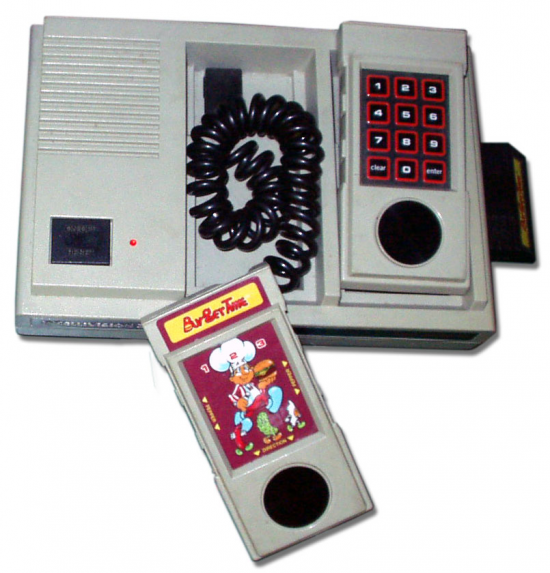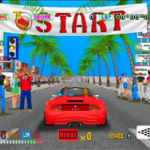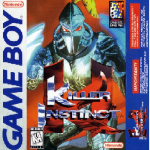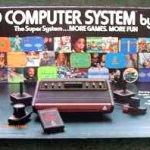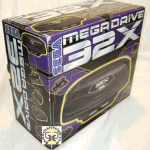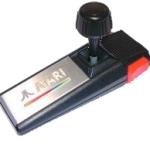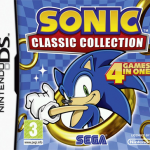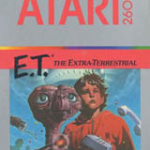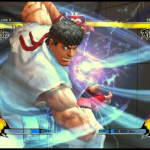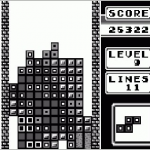The Mattel Intellivision (a blend of intelligent and television) was given a test release in California in 1979; A total of 4 games were available in this test release). It was then given a full release in the States in 1980. It was sold for $299 and came bundled with two games: Las Vegas Poker and Blackjack.
Mattel, a large toy and electronic games company, aggressively marketed the Intellivision as a better option than the Atari 2600. Their advertisements boasted that the Intellivision was a much higher spec than the 2600 (which was called the Atari VCS at the time) and listed many reasons why the Intellivision was better.
They also heavily promoted the fact that a keyboard would be released with their infamous Play games and balance your checkbook! promotional campaign, which would turn the Intellivision into a fully functional computer. Much to a lot of peoples disappointment, the keyboard never came. Though in 1983 the Entertainment Computer System was released, but it was too little too late.
The Intellivision did sell pretty well though, managing to take a good share of the market from Atari by shipping more than 5 million systems.
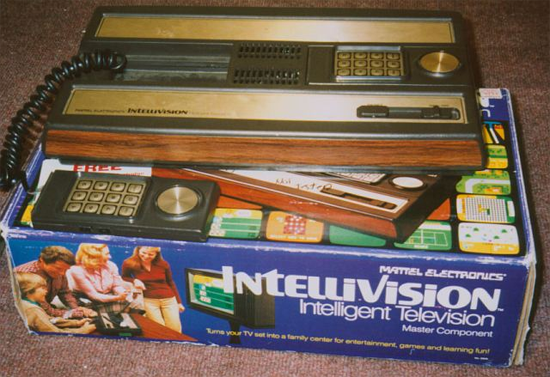
The console design was pretty basic. The game cartridges were input at the right hand side of the console. On the top of the console there was the power switch and spaces for the 2 attached wired controllers to sit when not using them. At the front there was the standard woodgrain finish, which so many consoles of the 70s at the time had.
The controllers had 12 numeric keys, 4 action buttons on the side and a circular dial which could move in 16 directions. They also had a space for an overlay to be inserted, users simply changed the overlay depending on the game (some example overlays can be found below).

Though the overlays made the controllers more versatile, many users complained about the design. A common complaint was a users hands becoming sore after extended use.
The computer games industry crash of 1983 was a big factor in the developments of the console in 1983. In 1984, Mattel become one of the many victims of that fateful year by suffering massive losses and leaving the games industry altogether.
Specifications
The Intellivision used a 16-bit CPU from General Instruments called the CP1610, which was clocked at 894.886 kHz. It had 7168 bytes of ROM and 1456 bytes of RAM.
Developers could use all colours from the 16 colour palette at the same time. It displayed a resolution of 160×196 pixels and the General Instrument audio chip AY-3-8910 allowed it to output 3 channels of sound.
Peripherals
Mattel released a few major add ons for the Intellivision. The most documented peripheral is undoubtedly the Entertainment Computer System, which was a PR mess from start to finish.
Entertainment Computer System
Mattel had heavily persuaded users to purchase the Intellivision at launch by promising them that a keyboard would be released which would turn the console into a fully functional computer. This would be achieved by adding 16K of RAM to the keyboard (which would be expandable up to a huge 8mb), an integrated cassette drive for storage and a secondary CPU. They also promised a printer accessory too.
They had originally planned to release the console in 1981 but as Mattel began to develop the keyboard, they soon realised that the original design was too ambitious and it would be much to expensive to develop and sell. Because of this delay, the Federal Trade Commission started to investigate them for false advertising due to thousands of complaints. In the Summer of 1982 the FTC started to fine Mattel $10,000 a day until the promised upgrade was made available to customers.
Their plan B was to develop a low cost version of the original plans. The final product was called the Entertainment Computer System and was released at the end of 1982. It only had 2kb of RAM, a cassette deck with reduced features and no secondary CPU. However the ECS did have a secondary audio chip, which increased the sound capabilities of the system. By connecting an optional 49-key music synthesizer keyboard users could record and play music. And with the extra ports users could connect 4 game controllers instead of 2.
The add on wasn’t particularly successful.
Intellivoice Voice Synthesis Module
Another peripheral was the Intellivoice Voice Synthesis Module, which was released in 1982. The module inserted into the units cartridge slot and allowed users to generate audio speech, utilising the modules 16kb of ROM.
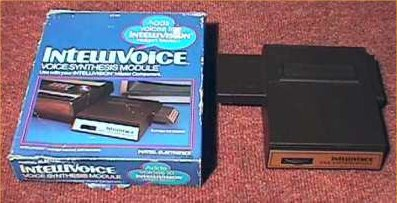
Only 5 games were released for the module: Space Spartans, Bomb Squad, B-17 Bomber, Tron: Solar Sailer and Intellivision World Series Major League Baseball.
The module wasn’t very successful. It was released for around $100. Game cartridges for the system normally sold for $40 but quickly dropped in price. However, games which used the Intellivoice were priced at $45 and didn’t really drop in price.
The games themselves were not great. Most of the cartridges only had 4 or 8 kb of ROM, which wasn’t enough for them to do what they wanted to do. Because of this, low quality sampling rates were used instead.
Complete Game List
In total, around 125 games were released for the Intellivision:
ABPA Backgammon
Advanced Dungeons & Dragons (AKA Adventure, Cloudy Mountain, Misty Mountain)
Advanced Dungeons & Dragons: Treasure of Tarmin
Armor Battle (Mattel/INTV)
Armor Battle (Sears)
Astrosmash (Mattel/INTV)
Astrosmash (Sears)
Atlantis
Auto Racing (Mattel/INTV)
Auto Racing (Sears)
B-17 Bomber
Backgammon
Baseball (Mattel/INTV)
Baseball (Sears)
Basketball
Beamrider
Beauty & The Beast
Big League Baseball
Blockade Runner I
Body Slam Super Pro Wrestling
Bomb Squad
Bowling
Boxing (Mattel/INTV)
Boxing (Sears)
Bump ‘N Jump
Burgertime
Buzz Bombers
Carnival
Centipede
Championship Tennis
Checkers (Mattel/INTV)
Checkers (Sears)
Chess
Chip Shot Super Pro Golf
Commando
Congo Bongo
Conversational French
Defender
Demon Attack
Dig Dug
Diner
Donkey Kong
Donkey Kong Jr.
Dracula
Dragonfire
Draughts
Dreadnaught Factor, The
Fathom
Football
Frog Bog
Frogger
Golf
Happy Trails
Hockey
Horse Racing (Mattel/INTV)
Horse Racing (Sears)
Hover Force
Ice Trek
Jetson’s Way with Words
Kool-Aid Man
Lady Bug
Las Vegas Poker & Blackjack (Mattel/INTV)
Las Vegas Poker & Blackjack (Sears)
Las Vegas Roulette (Mattel/INTV)
Las Vegas Roulette (Sears)
Learning Fun I
Learning Fun II
Lock ‘N Chase
Loco-Motion
Major League Baseball
Masters of the Universe: The Power of He-Man
Math Fun, The Electric Company
Melody Blaster
Microsurgeon
Mind Strike
Mission X
Motocross
Mountain Madness Super Pro Skiing
Mouse Trap
Mr. Basic Meets Bits ‘N Bytes
NASL Soccer
NBA Basketball
NFL Football
NHL Hockey
Night Stalker (Mattel/INTV)
Night Stalker (Sears)
Nova Blast
Number Jumble
Pac-Man (Atarisoft)
Pac-Man (INTV)
PBA Bowling
PGA Golf
Pinball
Pitfall!
Pole Position
Popeye
Q*Bert
Reversi
River Raid
Royal Dealer
Safecracker
Scooby Doo Maze Chase
Sea Battle (Mattel/INTV)
Sea Battle (Sears)
Sewer Sam
Shark! Shark!
Sharp Shot
Skiing
Slam Dunk Super Pro Basketball
Slap Shot Super Pro Hockey
Snafu
Soccer
Space Armada (Mattel/INTV)
Space Armada (Sears)
Space Battle (Sears)
Space Battle (Action Network) (Mattel/INTV)
Space Battle (Space Network) (Mattel/INTV)
Space Hawk (Mattel/INTV)
Space Hawk (Sears)
Space Spartans
Spiker! Super Pro Volleyball
Stadium Mud Buggies
Stampede
Star Strike (Mattel/INTV)
Star Strike (Sears)
Star Wars: The Empire Strikes Back (Parker Bros. game)
Sub Hunt
Super Cobra
Super Pro Decathlon
Super Pro Football
Swords & Serpents
Tennis (Mattel/INTV)
Tennis (Sears)
Thin Ice
Thunder Castle
Tower of Doom
Triple Action (Mattel/INTV)
Triple Action (Sears)
Triple Challenge
Tron Deadly Discs
Tron Maze-a-Tron
Tron Solar Sailer
Tropical Trouble
Truckin’
Turbo
Tutankham (Parker Brothers)
US Ski Team Skiing
USCF Chess
Utopia (Mattel/INTV)
Utopia (Sears)
Vectron
Venture
White Water!
Word Fun, The Electric Company
World Championship Baseball
World Series Major League Baseball
Worm Whomper
World Cup Soccer
Zaxxon
Variations
In 1983 Mattel released the Intellivision II, a redesign of the original Intellivision. It was presented in a new slick case and came with detachable controllers. A new music keyboard which worked with the ECS was also made available. The system also had a new external power supply instead of an internal one.
However, the main selling point was the addition of the System Changer, which allowed users to play Atari 2600 games.
The controllers were slightly different too with the bubble buttons being replaced with membrane style keys and the paddle being slightly different too. These changes were not popular with many people as the original games did not play as well with these new style controllers.
The console was released under a different name by some 3rd parties though the official console is by far the most recognised.
